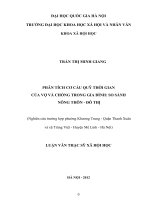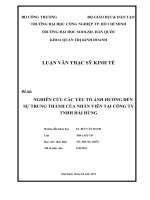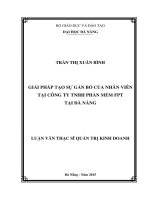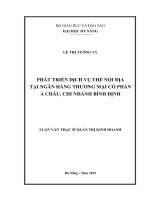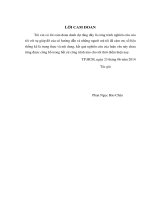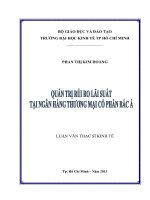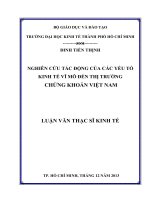(Luận văn thạc sĩ) teachers’ and students’ attitudes towards using language games to teach vocabulary a study at a primary school in hanoi
Bạn đang xem bản rút gọn của tài liệu. Xem và tải ngay bản đầy đủ của tài liệu tại đây (725.59 KB, 74 trang )
VIETNAM NATIONAL UNIVERSITY, HANOI
UNIVERSITY OF LANGUAGES AND INTERNATIONAL STUDIES
FACULTY OF POST-GRADUATE STUDIES
HOÀNG THỊ NGA
TEACHERS’ AND STUDENTS’ ATTITUDES TOWARDS
USING LANGUAGE GAMES TO TEACH VOCABULARY:
A STUDY AT A PRIMARY SCHOOL IN HANOI
(Quan điểm của giáo viên và học sinh đối với việc sử dụng trò chơi trong
việc dạy từ vựng: một nghiên cứu tại một trường tiểu học tại Hà Nội)
M.A MINOR PROGRAMME THESIS
MAJOR: ENGLISH TEACHING METHODOLOGY
CODE: 8140231.01
SUPERVISOR: PROF. HOÀNG VĂN VÂN
HANOI - 2020
DECLARATION
I, Hoang Thi Nga, state that the minor thesis, entitled “Teachers’
and students’ attitudes towards using language games to teach
vocabulary: a study at a primary school in Hanoi” is my own research
result and that it has not been submitted for any other universities and
institutes.
Hanoi, 2020
Student‟s signature
Hoàng Thị Nga
i
ACKNOWLEDGEMENTS
First and foremost, I would like to express my sincere gratitude to
Prof. Hoàng Văn Vân, my supervisor for his invaluable advice. During
this thesis writing period, he provided much helpful guidance and
encouragement. Without constructive criticism, precious correction, my
thesis could not have been completed.
My thanks also go to all of the lecturers and staff of the Faculty of
Post-Graduate Studies, University of Languages and International
Studies, Vietnam National University, Hanoi for their valuable lectures
and useful materials.
I am also thankful to all the English teachers and students at Van
Con Primary School for answering the questionnaires, which are
indispensable for the analysis and discussion in my study.
Last but not least, my hearted thanks are reserved for my family
and friends for their love and support that have encouraged me a lot in
conducting this thesis.
ii
ABSTRACT
The current study aims at helping fifth-grade students at a primary
school in Hanoi to improve their vocabulary learning through language
games. The school chosen for the study is Van Con Primary School in
Hanoi. The quantitative and qualitative methods are employed for the
study. Therefore, it is an attempt to investigate the teachers and students‟
attitudes towards using language games to teach vocabulary. The subjects
of the study are 05 English teachers and 106 fifth-grade students (03
classes) from Van Con Primary School in Hanoi. The data have been
gathered via survey questionnaires for both the teachers and students and
informal interviews only for the teachers. The first finding indicates the
majority of the teachers and students have positive attitudes when
applying language games to teach vocabulary. The second finding is that
most of the teachers have applied different types of sources of word
games in teaching vocabulary. However, there are some certain
limitations. They mainly use language games to present new words but
not really call interest from their students or motivate them in learning
new words. This means that they have not yet made advantage of its
potentials. The final finding shows some possible difficulties faced by the
teachers and the students when using language games to teach and learn
vocabulary.
Based on the findings, some recommendations, it is hopeful that
the study can be support to the teachers and students at Van Con Primary
School for reference to teach and learn vocabulary more effectively.
iii
TABLE OF CONTENTS
Pages
DECLARATION………………………………………………………..
i
ACKNOWLEDGEMENTS…………………………………………….
ii
ABSTRACT…………………………………………………………….
iii
TABLE OF CONTENTS……………………………………………….
iv
LIST OF TABLES AND FIGURES…………………………………...
vi
CHAPTER 1: INTRODUCTION………………………………...........
1
1. Rational of the study……………………………………………...
1
2. Aim and objectives of the study………………………………….
2
3. Research questions………………………………………………..
2
4. Scope of the study…………………………………………………
2
5. Methods of the study……………………………………………..
3
6. Significance of the study………………………………………….
4
7. Structure of the study……………………………………………
5
CHAPTER 2. LITERATURE REVIEW……………………….....
6
2.1. Attitudes in teaching and learning foreign language………
6
2.1.1. Definition of attitude………………………………………
6
2.1.2. The role of attitude in language learning……………………
7
2.2. Games in teaching and learning language……………………
8
2.2.1. Definition of language games………………………………
8
2.2.2. Types of language games……………………………………
10
2.2.3. Benefits in using language games to teach vocabulary……..
12
2.3. Vocabulary in teaching and learning language…………….
15
2.3.1. Definition of vocabulary……………………………………
15
2.3.2. The role of vocabulary in language learning………………...
16
2.3.3. Techniques to teach vocabulary through games……………..
17
iv
CHAPTER 3. RESEARCH METHODOLOGY…………………..
20
3.1. Context of the study…………………………………….......
20
3.1.1. The textbook………………………………………………
20
3.1.2. The subjects………………………………………………..
20
3.2. Data collection instruments and procedures……………..
21
3.2.1. Instruments……………………………………………..
21
3.2.2. Procedures………………………………………………
24
24
3.3. Summary
CHAPTER 4: DATA ANALYSIS AND DISCUSSION…………..
26
4.1. Teachers’ attitudes towards the use of language games in
26
teaching vocabulary…………………………………………………
4.2. Students’ attitudes towards the use of language games in
34
learning vocabulary…………………………………………………
4.3. Results from interview for teachers ……………………….
45
4.4. Discussion…………………………………………………….
49
4.3. Summary……………………………………………………..
51
CHAPTER 5: CONCLUSION……………………………………..
52
5.1. Recapitulation………………………………………………..
52
5.2. Concluding remarks…………………………………………
53
5.3. Limitations and suggestions of the study…………………..
54
REFERENCES………………………………………………………
52
APPENDICES……………………………………………………….
I
APPENDIX 1………………………………………………………..
I
APPENDIX 2………………………………………………………..
III
APPENDIX 3………………………………………………………...
VI
v
LISTS OF TABLES AND FIGURES
Table 1: Teachers’ ways of using language games to teach vocabulary and its
frequency of use…………………………………………………………………………...
Pages
30
Table 2: Sources to get games by teachers…………………………………………….
Table 3: Challenges faced by teachers in using language games to teach
31
32
vocabulary………………………………………………………………………………….
Table 4: The reasons for the students’ interest in learning vocabulary through
language games……………………………………………………………………………
42
Table 5: The reasons for the students’ de-motivation in learning vocabulary
44
through language games…………………………………………………………………
Table 6: Any problems in learning vocabulary through language games………..
Figure 1: Teachers’ use of language games to teach vocabulary………………….
Figure 2: Teachers’ interest in using language games to teach vocabulary…….
45
27
27
Figure 3: Teachers’ evaluation of language games in general…………………….
Figure 4: Teachers’ frequency of language games in teaching vocabulary……..
Figure 5: Language games’ availability……………………………………………….
Figure 6: Any problem encountered by teachers when using language games in
the processing of teaching vocabulary…………………………………………………
28
29
30
32
Figure 7: The role of vocabulary in language teaching……………………………...
35
Figure 8: Students’ interest when learning English vocabulary through using
language games by teachers in lessons………………………………………………..
Figure 9: Students’ evaluation on the usefulness of games in learning
vocabulary…………………………………………………………………………………
Figure 10: Level to learn vocabulary thanks to language games…………………..
Figure 11: Students’ attitudes towards the effectiveness of language games…….
Figure 12: Students’ evaluation on their teachers’ frequency of using language
games to teach vocabulary………………………………………………………………
Figure 13: Students’ attitudes towards using language games to learn new
words in the options below………………………………………………………………
Figure 14: Teachers’ frequency in the use of language games to teach
vocabulary to students……………………………………………………………………
Figure 15: Teachers’ enjoyment in teaching vocabulary and their reasons………
36
vi
37
38
40
41
45
47
CHAPTER 1: INTRODUCTION
1. Rationale for the study
Nowadays in Vietnam, teaching and learning English has become a
topical issue emerging for concerns of both learners and researchers. It has
become an international language which is used widely all over the world,
especially after Vietnam‟s integration into the WTO, learning English gets
more important in the all the fields of social life such as economy,
technology, diplomacy, foreign trade, education and tourism. Therefore,
teaching and learning English has become ever urgent issue for everyone
anywhere.
In the recent years, English has been taught in the light of the
communicative and learner-centered approach which gives students more
chances to communicate. However, teaching and learning English has been
out of learners‟ satisfaction. Both teachers and especially students are facing
difficulty in teaching and learning English vocabulary. They are really
difficult to read and remember. In fact, many students cannot remember
words for a long time and even cannot apply them in practice, especially in
speaking, listening and writing skills.
Van Con Primary School in Hanoi is not an exception, English learning
situation here is that the students find it hard to learn and remember new
words although there are many techniques used during lessons such chants,
songs, telling stories… all are not really effective. Hence, using games in
teaching vocabulary is bringing surprising results; this shows in the learning
attitudes of the students. Use of language games not only helps students
remember new words faster and better but also motivates them in learning and
using English as well.
1
Theoretically, many linguists in the world have studied the use of
language games in teaching vocabulary, and in Vietnam, there have been
many such research works, but no one has studied about the teachers‟ and
students‟ attitudes towards using language games to teach vocabulary at a
primary school. In practical terms, in the course of its teaching, the researcher
finds that the application of the game brings many practical benefits. From the
above-said reasons, the researcher wants to conduct this research based on a
practical basis for the purpose of enhancing the use of language games to
improve vocabulary for primary students.
2. Aims and objectives of the study
Aims of the study
The aim of the study is to find out the teachers‟ and students‟ attitudes
towards using language games to improve students‟ vocabulary in the context
of a primary school in Hanoi.
Objectives of the study
To be more specific for the aim of the study, this study has been carried
out to explore:
- To investigate teachers‟ and students‟ attitudes to teach and learn
vocabulary through using games.
- To investigate the extent of game sources applied to teach vocabulary.
- To investigate difficulties faced by the teachers and students.
3. Research questions:
- What are the teachers‟ and students‟ attitudes towards using language
games to teach vocabulary?
- To what extent have language games been used in teaching and
learning vocabulary?
2
- What are the problems faced by the teachers and students when
teaching and learning vocabulary through language games?
4. Scope of the study
The research has been conducted in a primary school in Hanoi. The
research aims at investigating attitudes of teachers and students towards using
language games. The researcher would like to discover how vocabulary
games are applied to teach and learn new words in the English learning
classes and difficulties faced by the teachers and students. The study has been
conducted with the participation of 106 fifth-grade students of Van Con
Primary School in Hanoi.
5. Methods of the study
This study uses both qualitative and quantitative methods. Data
collections for analysis originate from the teachers and the students at the
primary school by instruments:
- Survey questionnaires
- Informal interviews
6. Signification of the study
It is hoped that the findings of the study will be useful to the teachers of
English as well as provides the teachers with the benefits of using language
games in teaching language, especially teaching vocabulary. It will help the
teachers to realize their students‟ attitudes towards using language games to
improve vocabulary. The study also suggests the ways of using games in
lessons.
7. Organization of the thesis
The study is divided into five chapters:
Chapter 1 – “Introduction” provides the rationale for the study, aim
and objectives of the study, scope, methodology and structure of the study.
3
Chapter 2 “Literature review” provides overview of theoretical
background of attitude, vocabulary, brief views of language games and
benefits of using language games in teaching and learning vocabulary.
Chapter 3 “Methodology” describes an overview on setting, textbook,
instruments used in the survey. In addition, the details of teachers and
students at the primary school are supplied.
Chapter 4 “Data Analysis and Discussion” is related to collecting the
data from Van Con Primary School in Hanoi and analyzing the data to find
out the teachers‟ and students‟ attitudes towards using language games in
teaching vocabulary to primary learners. In addition, the data is collected in
order to find out game sources preferred by the teachers, and some difficulties
faced by the teachers and students as well as suggestions for choice of
suitable games to teach vocabulary.
Chapter 5 – Conclusion – sums up what has been studied, provides
some recommendations for the teachers and students and points out the
limitations of the thesis, and suggestion for further studies.
4
CHAPTER 2: LITERATURE REVIEW
This chapter is to aim at providing a theoretical background to the
study. The review of the issues related to the study is included: definitions,
role of the attitudes in language learning. In addition, an overview of language
games, including their definitions, role in language learning, as well as
vocabulary with their definitions, role in language learning will be mentioned
clearly.
2.1. Attitudes in teaching and learning foreign language
2.1.1. Definition of attitude
In general, attitude can be understood as people‟s responses to a certain
thing. In fact, there are many researchers have different definitions of attitude
from various aspects. Specially, they distinguish language attitude from
general attitudes that language attitudes are precisely about language (Faso,
1984: 148). It can be understood that the language attitude refers to people
towards language.
According to Rayan and Giles (1982), language is “any affective,
cognitive and behavioral index of evaluation reactions towards different
language varieties or their speakers”. So, attitude is the way to feel, think and
behave to different languages in a certain situation.
Similar to the above-said opinions, Gardner (1985) also states that “an
individual‟s attitude is an evaluation reaction to some referent or attitude
object on the basics of the individual‟s beliefs or options about the referent”.
It leads that people‟s belief or perception can cause favorable or unfavorable
attitude to an object.
On the basis of Gardner‟s argument, Wenden (1991) scrubs general
definition of the attitude. He classifies attitude into three components:
behavioral, cognitive and affective.
The behavioral aspect of attitude
5
mentions the way one person behaves in a certain situation. The cognitive
component is shown in beliefs, ideas, and opinions about the attitude. The
affective component indicates the feeling of “like” or “dislike” the objects or
surrounding contexts. These components are relevant and they always appear
whenever a person has an attitude.
In addition, Baker (1992: 10) defines attitude as “a hypothetical
construct used to explain the direction and persistence of human behavior”.
So, from the point of view, attitude is the way which human people act and
behave in the specific situation to the object.
In summary, from the above-said definitions indicated that, attitude can
be seen as emotion affecting the behaviors of human beings. All people‟s
reaction and responses to certain things depend on attitude to this language.
Hence, attitude is an important factor in learning second language.
2.1.2 The role of attitudes in language learning
In consideration of the role of attitude in learning language, a lot of
studies have indicated that there is a reciprocal relationship among teachers‟
and students‟ attitudes. Attitudes towards a specific language might be either
positive or negative. In fact, that both positive and negative attitude decides
success or failure in learning language.
It is said that those have positive attitude towards the target language
might obtain higher proficiency in language learning. As stated by Gardner
and Lambert (1972) in the study, positive attitude toward a language can
strengthen students‟ proficiency.
Besides, Karahan (2007: 84) states that “positive language attitudes let
learners have positive orientation towards learning English”. He believes that
the students get more active in the processing of learning when they have
6
favorable attitudes, so their positive attitudes can enhance them to the target
language better.
From the above-said views, attitude is regarded as one of the most
essential factors influencing on the students‟ achievement in language
learning. It is obvious that language learners get many benefits when they
own positive attitudes. Hence, it is crucial to explore students‟ attitudes
towards the target language to enhance their positive attitudes and reduce
their negative ones.
2.2. Language games in teaching and learning language
2.2.1. Definition of language games
In general, games are forms of fun; they are physical activities or
mental activities or mixture both of them. According to Ludwig
Wittgenstein‟s game term, it refers to the linguistic practices around the use of
words, pragmatics that determine the meaning of the particular word in the
particular situation. Actually, games are a great way to learn all sorts of things
about English. These games are for English language learners, or native
speakers who are addicted to word games. Further, according to Rixon
(1974), “a game consists of play governed by rules”. And Gibb (1974) said “a
game is an activity carried out by cooperating or competing decision
markers, seeking to achieve, within a set of rules, their objectives”.
Therefore, there are different definitions of games, but its normal target
is to create funny activities in order to motivate learners in learning
vocabulary effectively.
Games used in English classes are regarded as one type of games
entitled language games. According to Hadfield‟s viewpoint (1996), language
games as activities with rules, a goal and an element of fun. Based on the
above-said definition, games help teachers generate language learning
7
activities. Learning language is a hard job, and learning new words becomes
more and more difficult. Students must master its meaning, pronounce and
know how to use them. Of course, learning language will take a long time.
Language games can help students feel interested, motivate to learn naturally.
In addition, language games allow the teachers to create the contexts in which
words are meaningful, students can remember new words for a long time and
save time in learning.
Language games are considered as task based according to Lewis
(1999, p.5), language game is a tool to help students achieve their language
goals. To participate in a language game, the teachers must provide a set of
rules that guide students to understand their actions ad strategies.
Also, according to Richard-Amato (1996), even though games are often
associated with fun, we should not lose sight of their pedagogical values,
particularly in second language teaching. Games are effective because they
provide motivation, lower students‟ stress, and give them the opportunity for
real communication.
Furthermore, language games maybe carried out by a group, a pair of
learners, and of course they are competitive. Students‟ task is obtaining prize,
goal to beat other groups. According to Greenal (1984), language games are
regarded as “activity which is used to consolidate language already taught or
acquired and occurs during the free stage of lesson or during occasions such
as English club meeting.
In short, language games can be used any stage of lesson to present new
words or check old words in order to help student remember and retain
vocabulary better and longer. Language games are physical, mental or used
both, and participants are groups or individuals or pairs and game rules must
8
clear a certain goal. Besides, word games enable learners to pronounce clearly
and correctly that help others understand them and follow.
2.2.2. Types of language games
Language learning can be a hard task and sometimes it can be stressing.
Continuous effort is required to properly understand, pronounce and
manipulate a new language. Therefore, games are considered as very relaxing
and effective tools for teaching and learning a language because they create
motivation, lower stress for students, and provide the opportunity for real
communication to learners.
According to Hadfield (1999), language games are used into 2
categories - linguistic and communicative games. He stated that linguistic
games emphasis on accuracy, for instance, it provides the right synonyms and
antonyms. In contrast, communicative games presume successful interchange
of information and ideas. Actually, games have an excessive academic value
and it can be used in the classroom to make learners use the language in place
of thinking about learning the right forms. Games encourage learners to work
together, be creative, cooperative and impulsive in using the language in a
significant way. Students want to participate in activities to play games and
are normally relatively competitive.
Language games have many more categories in viewpoint of Hadfield
(1999). As with the classification of games as linguistic games or
communicative games, some games will contain elements of more than one
type:
Sorting, ordering, or arranging games.
For example, students have a set of cards with different products on them,
and they sort the cards into products found at a grocery store and products
found at a department store.
9
Information gap games.
In such games, one or more people have information that other people
need to complete a task. For instance, one person might have a drawing and
their partner needs to create a similar drawing by listening to the information
given by the person with the drawing. Information gap games can involve a
one-way information gap, such as the drawing game just described, or a twoway information gap, in which each person has unique information.
Guessing games.
These are a variation on information gap games. One of the best-known
examples of a guessing game is 20 questions, in which one person thinks of a
famous person, place, or thing. The other participants can ask 20 Yes/No
questions to find clues in order to guess who or what the person is thinking of.
Matching games.
As the name implies, participants need to find a match for a word, picture,
or card. For example, students place 30-word cards, composed of 15 pairs,
face down in random order. Each person turns over two cards at a time, with
the goal of turning over a matching pair, by using their memory.
Labeling games.
These are a form of matching, in that participants match labels and
pictures.
Role-play games.
The terms role play, drama, and simulation are sometimes used
interchangeably but can be differentiated (Kodotchigova, 2002). Role play
can involve students playing roles that they do not play in real life, such as
doctor, while simulations can involve students performing roles that they
already play in real life or might be likely to play, such as customer at a
restaurant. Dramas are normally scripted performances, whereas in role plays
10
and simulations, students come up with their own words, although preparation
is often useful.
In summary, the researcher has just provided some types of games to help the
teachers design suitable games for each lesson as well as basis for the
researcher to study the next steps.
2.2.3. Benefits in using language games to teach vocabulary
There
are
numerous
techniques
concerned
with
vocabulary
presentation. However, there are a few things that have to be remembered
irrespective of the way new lexical items are presented. If teachers want
students to remember new vocabulary better, it needs to be learnt in context,
practiced, and then revised to prevent students from forgetting. Teachers must
make sure students have understood the new words, which will be
remembered better if introduced in a «memorable way». Bearing all this in
mind, teachers have to remember to employ a variety of techniques for new
vocabulary presentation and revision. The researcher believes that one of the
effective ways of vocabulary presentation is using games.
Games are used as a technique or method to engage learners in learning
a new language with fun and easiness. Well selected and premeditated games
are helpful as they provide learners a break and simultaneously allow them to
practice language skills. The benefits of games from the perceptive feature of
learning to more co-operative group dynamics and as a result games are very
motivating at the same time challenging.
Naturally when playing games, students are trying to win or to beat
other teams for themselves or on the behalf of their team. They are so
competitive while playing because they want to have a turn to play, to score
points and to win. In the class, students will definitely participate in the
activities. Therefore, it is possible for a teacher to introduce students to new
11
words. As in the dictation game, students are so competitive that they want to
finish first and win. It can be clearly seen that games can capture students‟
attention and participation. They can motivate students to want to learn more.
Moreover, they can transform a boring class into a challenging one.
Games are often used in language classes is that they lower students‟
stress in the classroom. In conventional classrooms, there is a lot of stress put
on students trying to master the target language. Schultz (1988) said that
“...Stress is a major hindrance in language learning process. This process
[Learning language in traditional way] is by its nature time consuming and
stress provoking... ...raise the stress level to a point at which it interferes with
student attention and efficiency and undermines motivation. ..... One method
has been developed to make students forget that they are in class ....relax
students by engaging them in stress reducing task (games).”
As a result, games can help lower their anxiety, make them feel
comfortable, and want to learn more. It is believed that when students play
games, they relax and have fun. Since students know that they are playing
games and want to communicate efficiently they do not worry about making
mistakes and do not try to correct themselves in every single sentence. When
students are free from worry and stress, they can improve their fluency and
natural speaking styles.
Another advantage is increasing students‟ proficiency. Playing games
in the classroom can enormously increase students‟ ability in using language
because students have a chance to use language with a purpose in the
situations provided. Hadfield (1990) confirms that “games provide as much
concentrated practice as a traditional drill and more importantly, they
provide an opportunity for real communication, albeit within artificially
defined limits, and thus constitute a bridge between classroom and the real
12
word.” Like in a traditional classroom, students have an opportunity to drill
and practice using grammatical rules and other functions.
On the other hand, Lee Su Kim (1995) mentioned that there is a
common perception that all learning should be serious and solemn in nature
and that if one is having fun and there is hilarity and laughter, then it is not
really learning. This is a misconception. It is possible to learn a language as
well as enjoy oneself at the same time. One of the best ways of doing this is
through games.
According, below are advantages of using games in the classroom by Lee Su
Kim (1995):
Games are a welcome break from the usual routine of the language
class.
They are motivating and challenging.
Learning a language requires a great deal of effort, games help students
to make and sustain the effort of learning.
Games provide language practice in the various skill-speaking, writing,
listening and reading.
They encourage students to interact and communicate.
They create a meaningful context for language use.
According to Nguyen Thi Thanh Huyen and Khuat Thi Thu Nga written in
the Asian EFL Journal in (2003), that there are advantages and effectiveness
in learning vocabulary in various ways through games. Firstly, games bring in
relaxation and fun for students, thus help them learn and retain new words
more easily. Secondly, game gives friendly competition and they keep
learners interested. These create the motivation for English learners to get
involved and participate actively in the learning activities. Thirdly,
13
vocabulary games bring real world context into the classroom, and enhance
students‟ use of English in a flexible, communicative way.
Hence, vocabulary games brings many benefits and we use them flexibly
in each situation and in each stage of various lessons. From the above-said
theories, games are used not only for mere fun, but more importantly, for the
useful practice and review of language lessons, thus leading toward the goal
of improving learners‟ communicative competence.
In short, the researcher has just given some benefits in using language
games in order to help the teachers understand its values and encourage them
to use games because of its great advantages. In addition, it is a basis for the
researcher to make the next steps in this study.
2.3. Vocabulary in teaching and learning language
2.3.1. Definition of vocabulary
Vocabulary was defined as “the words we teach in the foreign
language.” It was recognized as “a new item of vocabulary may be more than
a single word: for example, post office and mother-in-law, which was made
up of two or three words but express a single idea” in the view of Ur
(1996:60). In addition, the viewpoint of Pyles and Algeo (1970: 96) is that
“vocabulary is the focus of language with its sound and meaning, which
interlock to allow us to communicate with one another, and it is words that
we arrange together to make sentences, conversation and discourse of all
kinds”. It is referred that the vocabulary is very important in the process of
learning languages in general and especially in learning foreign languages in
particular.
Moreover, in the view of Morgan and Rinvolucri (1986), “A word is a
basic unit of a language denoting concepts, things and phenomena in the
society”.
14
In summary, there are different ways of defining vocabulary, each of
them presents definition of vocabulary in their understanding, but there is a
same point that vocabulary items more than single words. Therefore,
vocabulary consists of a bigger aspect of language and it is a medium for
language learners to express their ideas. It is considered that vocabulary is as
a means for people to communicate. Without words, we are very difficult to
transform information.
The researcher has provided some definitions of vocabulary in order to
prove that vocabulary is interested by the linguistic writers in the world, and
is also affirmed to play an important role in learning language. That is an
urgent topic interested by the researcher in the study process.
2.3.2. The role of vocabulary in language learning
According to David Wilkins (1972), “Without grammar very little can
be conveyed, without vocabulary nothing can be conveyed”. As above said,
vocabulary can be regarded as the most important part of a language, to
communicate successfully, we need to have vocabulary firstly, maybe we do
not use grammar structure fluently, but based on new words provided,
audience can still understand what we have said. Similarly, McCarthy (1990:
viii) emphasizes that: “No matter how well the student learns grammar, no
matter how successfully the sounds of L2 are mastered, without words to
express a wider range of meanings, communication in an L2 just cannot
happen in any meaningful way”. This is why teaching and learning
vocabulary can serve the communicative purposes.
Clearly, the rich vocabulary helps learners communicate better. They
have many words to express their ideas and understand others‟ thought. The
rich vocabulary also promotes four skills: listening, speaking, reading and
writing.
15
This explains why learning vocabulary is really important. Learning
vocabulary not only understands its meaning but also understand its forms
and usage. If someone has sufficient vocabulary, she/he will feel more
confident in communicating with others as well as expressing her/his ideas in
both oral and written forms. Learners know a lot of new words, and know
how to use them; they will success in the process of communication.
Folse (2004) defined that “the lack of grammar knowledge can limit
conversion; lack of vocabulary knowledge can stop conversation”.
Undeniably, vocabulary is the essential component of a language, teaching
and learning vocabulary should be seriously taken in account when teaching
English. Therefore, it is necessary to take vocabulary teaching activities as
integrated parts of teaching language skills, and as the basis to develop
learners‟ language skills.
It can be seen that the role of vocabulary in language learning is very
important and it is confirmed by linguists in the above definitions. This is also
the basis for the researcher to carry out the next research steps.
2.3.3. How to choose language games to teach effectively
Mei and Yu-jing (2000) affirmed that games are fun and it is important
that children like them. Through vocabulary games, children experiment,
discover, and interact with their environment. Through playing games,
students can learn English as children learn their mother tongue without being
aware they are studying. In other words, using games is to help students speak
English naturally; thus, without stress, they can learn much even shy students
can participate positively. Also, they point how to choose a suitable game:
A game must be more than just a fun.
A game should involve “friendly” competition.
A game should keep all of the students involved and interested.
16
A game should encourage students to focus on the use of language
rather than on the language itself.
A game should give students a chance to learn, practice, or review
specific language material.
It is possible students wish to play games purely for fun. Teachers,
however, need more convincing reasons.
Teachers should consider which games to use, when to use them, how to
link them up with the syllabus, text book or programmed, and how, more
specifically, different games will benefit students in different ways. The key
to a successful language game is that the rules are clear, the ultimate goal is
well defined and the game must be fun.
In summary, language games are good and useful tools in language
teaching and learning that English teachers should use to motivate their
students in learning process, especially teaching vocabulary. However, to
make the advantage of language games‟ benefits, teachers should understand
the characteristics of each type of games, and choose suitable ones in order to
bring the best effectiveness to their students.
In this section, the researcher has provided the ways to choose games to
teach vocabulary effectively, namely the ways are given by Mei and Yu-jing
(2000) that helps the researcher design questionnaires for the teachers and
students properly.
2.4. Summary
In brief, in this chapter the researcher has reviewed some definitions of
vocabulary and its importance in teaching and learning language in general
and teaching and learning vocabulary in particular. In addition, the issue of
games is a great concern. The researcher has dealt with some definitions of
games, its classification, its benefits brought in the process of use and ways to
17
choose a good game. Consequently, the researcher has an overview of game
and vocabulary, and can design the appropriate questionnaire in this study.
Understanding these things will lead to better analysis in the next chapter.
CHAPTER 3: RESEARCH METHODLOGY
In this chapter, subjects of the study, the instruments of the data
collection will be presented in detail as follows:
3.1 Context of the study
3.1.1. The textbook
The textbook Tiếng Anh 5 (English 5) is the third of the three-level
textbook series for Vietnamese primary school pupils. It is written by Hoàng
Văn Vân (General Editor), Phan Hà (Editor), Đỗ Thị Ngọc Hiền, Đào Ngọc
Lộc, Trương Thị Ngọc Minh with the collaboration of Ken Wilson (an
researcher of MacMillan Education) (2020a, 2020b). The textbook follows
the curriculum approved by the Ministry of Education and Training [MoET]
(2018) includes 20 units and 6 reviews. Each unit has a common structure of
3 Lessons/Unit and the knowledge consists of 4 parts: Competences, Sentence
patterns, Vocabulary and Phonics. At each Lesson, students are trained in
Listening - Speaking - Reading - Writing skills.
3.1.2. The subjects
18

